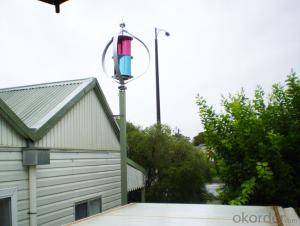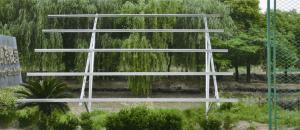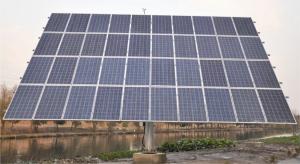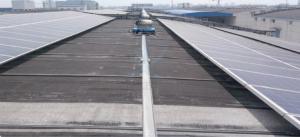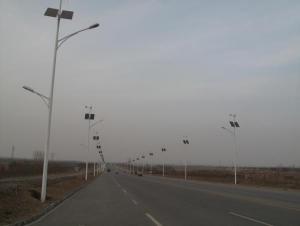Magnetic Levitation Wind Turbine Series CXF
- Loading Port:
- Shekou
- Payment Terms:
- TT or LC
- Min Order Qty:
- 10 set
- Supply Capability:
- 1000 set/month
OKorder Service Pledge
OKorder Financial Service
You Might Also Like
1.Structure of Magnetic Levitation Wind Turbine Series CXF
As one of the renweable energies , wind power is considered to be the important supplement for generating electricity. The maglev wind turbines undergoes a continuous improvement process, which incorporates exterior design, utility design, electrical engineering, dynamic engineering, power mechanics, aviation air engineering, wind tunnel testing, lightening protection, computer simulation techniques and other multiple subjects.
2.Main features of Magnetic Levitation Wind Turbine Series CXF
Magnetic levitation technology
Independent of the direction of the wind
Startup at low wind speed of 1m/s
Higher efficiency compared to traditional HAWT
Works even in turbulence
Visually pleasing appearance
Turbine construction is resistant to gale 60m/s (132MPH)
Robustness and adaptation to all possible environmental conditions thanks to material of aluminum alloy or stainless steel
Design life: at least 20 years
Noise: Tested by China National Machinery Quality Inspection Centre at 12m/s: <40db
3.Magnetic Levitation Wind Turbine Series CXF Specification
Items | CXF300 | CXF600 | CXF1000 | CXF3000-Ⅰ | CXF3000-Ⅱ |
Rated power | 300W | 600W | 1000W | 3000W | 3000W |
Dimension (Height/Diameter) | Ø1080/1240 | Ø1320/1540 | Ø2200/2400 | 3530/Ø3600 | Ø4160/4570 |
Weight | 27 | 50 kg | 180 kg | 415KG | 680 kg |
Blade material | Aluminum Alloy | Aluminum Alloy | Aluminum Alloy | Aluminum Alloy | Aluminum Alloy |
Blade quantity | 3 | 3 | 3 | 3 | 3 |
Swept area | 0.76 | 1.27 | 3.6 | 7.02 | 7.72 |
Min starting wind speed | 1m/s | 1.3m/s | 1.5 m/s | 1.5m/s | 1.5m/s |
Cut-in wind speed | 2.7 m/s | 2 7m/s | 3.5m/s | 3.5m/s | 3.5m/s |
Rated wind speed | 12m/s | 12m/s | 13m/s | 13m/s | 13m/s |
Cut-off wind speed | 15m/s | 15m/s | 15m/s | 15m/s | 15m/s |
Survival wind speed | 65m/s | 65m/s | 60m/s | 60m/s | 60m/s |
Generator type | AC,3Phases | AC,3Phases | AC,3Phases | AC,3Phases | AC,3Phases |
Controller Output Voltage | 12V/24V | 24V/48V | 48V | 48V | 96V |
Controller Braking System | 3-phase short circuit by NFB brake | 3-phase short circuit by NFB brake | 3-phase short circuit by NFB brake | 3-phase short circuit by NFB brake | 3-phase short circuit by NFB brake |
Ambient Temperature | -40~50 ℃ | -40~50 ℃ | -40~50 ℃ | -40~50 ℃ | -40~50 ℃ |
Noise | Noisy from National Machinery Quality Inspection Centre at 12m/s : <40db | ||||
4. Magnetic Levitation Wind Turbine Series CXF Images

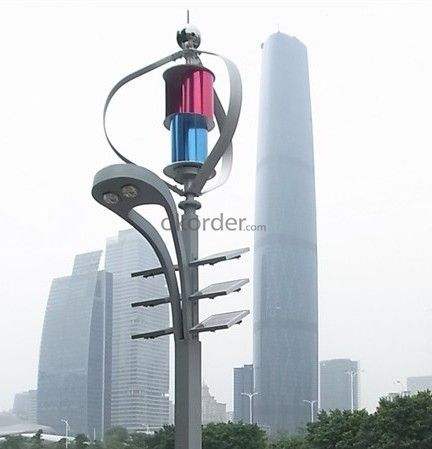
5. FAQ
Q1: Can I change the color of the blade?
Re: Surely you can customize the color of blade.
Q2: Is it difiicult to instal the wind turbine?
Re: It is easy for the installation, you can consult the mannual.
- Q:Are solar lights resistant to electromagnetic interference (EMI)?
- Yes, solar lights are typically resistant to electromagnetic interference (EMI). The photovoltaic cells used in solar lights are designed to convert sunlight into electricity, eliminating the need for external power sources that may be susceptible to EMI. Additionally, the low-voltage DC system of solar lights is less likely to create or be affected by electromagnetic interference compared to AC-powered devices.
- Q:How does a solar controller handle the protection against ground faults?
- A solar controller handles protection against ground faults by continuously monitoring the flow of electrical current in the solar system. It utilizes advanced circuitry and algorithms to detect any imbalances or leakage of current to the ground. Once a ground fault is detected, the solar controller immediately interrupts the circuit, preventing any potential damage to the system or electrical shock to humans or animals.
- Q:How much do solar lights cost?
- The cost of solar lights can vary depending on various factors such as the brand, quality, features, and the type of solar light you are looking for. On average, you can find a decent set of solar lights for your garden or pathway for around $20 to $50. These lights are usually equipped with LED bulbs and have basic features like automatic on/off sensors. If you are looking for more advanced solar lights with additional features such as motion sensors, adjustable brightness levels, or remote-controlled operation, the price can range from $50 to $100 or more. These lights are typically used for security purposes or to illuminate larger areas. For solar lights designed for specific purposes such as solar flood lights, solar spotlights, or solar string lights, the cost can vary even more depending on the size, brightness, and quality of the product. These lights can range from $20 to $200 or more. It is important to consider factors such as durability, battery life, and warranty when purchasing solar lights to ensure you get the best value for your money. Additionally, it is advisable to compare prices and read customer reviews to make an informed decision.
- Q:How do solar energy systems impact the overall sustainability of a home?
- Solar energy systems have a significant impact on the overall sustainability of a home. Firstly, they greatly reduce dependence on fossil fuels, which are finite and contribute to climate change. By harnessing the power of the sun, solar energy systems generate clean, renewable electricity that doesn't produce harmful emissions or pollutants. This not only helps to mitigate climate change but also improves air quality in the surrounding environment. Furthermore, solar energy systems provide homeowners with energy independence and resilience. By generating their own electricity, homeowners can reduce their reliance on the grid and avoid the volatility of energy prices. This can lead to long-term cost savings and greater financial stability. Additionally, during power outages or natural disasters, solar energy systems with battery storage can provide a reliable source of electricity, ensuring essential appliances and systems keep running. Solar energy systems also increase the energy efficiency of a home. By supplementing or replacing traditional energy sources, these systems reduce the overall energy consumption of a household. This, in turn, lowers utility bills and conserves resources. Moreover, the installation of solar panels can increase the value of a home. As renewable energy becomes more popular and desirable, potential homebuyers are increasingly willing to pay a premium for properties with solar energy systems. This not only benefits homeowners who are looking to sell their homes but also contributes to the overall growth and adoption of sustainable energy solutions. Lastly, solar energy systems promote a sense of environmental stewardship and sustainability. By utilizing renewable energy, homeowners can actively contribute to reducing their carbon footprint and preserving the planet for future generations. This commitment to sustainability extends beyond the household, inspiring others to embrace clean energy and work towards a greener future. In conclusion, solar energy systems have a positive and far-reaching impact on the overall sustainability of a home. They reduce dependence on fossil fuels, increase energy efficiency, provide energy independence and resilience, boost property value, and promote environmental stewardship. By harnessing the power of the sun, solar energy systems pave the way for a more sustainable and resilient future.
- Q:Can solar panels be installed on a flat roof?
- Yes, solar panels can be installed on a flat roof. In fact, flat roofs are often considered ideal for solar panel installations due to their easy accessibility and potential for optimal sun exposure. Additionally, there are various mounting systems available that can be used to securely attach solar panels to flat roofs.
- Q:Do solar chargers require any maintenance?
- Yes, solar chargers do require some maintenance. This typically involves keeping the solar panels clean and free from any dirt or debris that may reduce their efficiency. Additionally, regular inspection of the connections and cables is important to ensure proper functioning. Some solar chargers may also require occasional battery maintenance or replacement.
- Q:How does a solar controller handle the monitoring of system performance?
- A solar controller monitors the performance of a solar system by continuously measuring and analyzing key parameters such as solar panel voltage, current, and temperature. It also monitors the battery voltage and temperature in case of a battery-based solar system. By tracking these parameters, the solar controller can determine the overall system performance, identify any issues or faults, and take necessary actions such as adjusting the charging rate to optimize the system's efficiency and prevent overcharging or damage to the batteries. Additionally, some advanced solar controllers may offer remote monitoring capabilities, allowing users to access real-time performance data and receive alerts or notifications about system performance through mobile apps or online platforms.
- Q:How does the size of the solar pump motor affect its performance?
- The performance of the solar pump is significantly affected by the size of its motor. The motor size has a direct impact on both the power output and efficiency of the pump. When the motor is larger, it generally means that the power output is higher. As a result, there is an increased water flow and higher pressure. This is particularly important for situations that require pumping water over long distances or to higher elevations. With a larger motor, more force can be generated, allowing it to overcome friction and deliver water with greater speed and force. Furthermore, a larger motor has the capability to handle a higher workload and operate for longer periods without overheating. It can manage larger volumes of water and work more efficiently, thereby reducing energy consumption and improving the overall effectiveness of the solar pump system. Conversely, a smaller motor may have limitations in terms of power output and efficiency. It may struggle to provide sufficient water flow and pressure, especially for demanding applications. A smaller motor may also have a lower workload capacity, resulting in more frequent breakdowns and reduced longevity. Choosing the appropriate motor size is crucial and should align with the intended application and specific requirements of the solar pump system. Factors such as the desired water flow rate, required pressure, and the distance and elevation at which the water needs to be pumped are all essential considerations when determining the suitable motor size. To summarize, the performance of the solar pump is directly influenced by the size of its motor. A larger motor can offer higher power output, increased water flow, and improved efficiency, while a smaller motor may have limitations in these areas. Selecting the right motor size is essential to ensure optimal performance and reliability of the solar pump system.
- Q:Can a solar pump be used in areas with limited access to water systems?
- Yes, a solar pump can be used in areas with limited access to water systems. Solar pumps are independent of grid electricity and can be easily installed in remote locations where traditional water systems are not available. These pumps utilize solar energy to draw water from wells, boreholes, or other water sources, making them a sustainable and reliable option for areas with limited access to water systems.
- Q:Can solar panels be leased or financed?
- Yes, solar panels can be leased or financed. Many companies offer leasing or financing options for solar panel installation, allowing homeowners and businesses to enjoy the benefits of solar power without the upfront cost. Leasing or financing arrangements typically involve monthly payments over a set period of time, making solar energy more accessible and affordable for a wider range of people.
1. Manufacturer Overview |
|
|---|---|
| Location | |
| Year Established | |
| Annual Output Value | |
| Main Markets | |
| Company Certifications | |
2. Manufacturer Certificates |
|
|---|---|
| a) Certification Name | |
| Range | |
| Reference | |
| Validity Period | |
3. Manufacturer Capability |
|
|---|---|
| a)Trade Capacity | |
| Nearest Port | |
| Export Percentage | |
| No.of Employees in Trade Department | |
| Language Spoken: | |
| b)Factory Information | |
| Factory Size: | |
| No. of Production Lines | |
| Contract Manufacturing | |
| Product Price Range | |
Send your message to us
Magnetic Levitation Wind Turbine Series CXF
- Loading Port:
- Shekou
- Payment Terms:
- TT or LC
- Min Order Qty:
- 10 set
- Supply Capability:
- 1000 set/month
OKorder Service Pledge
OKorder Financial Service
Similar products
New products
Hot products
